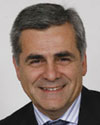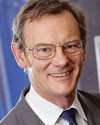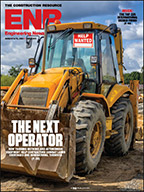With global ties growing among engineering firms, CEOs of several fast-growing non-U.S.-based players noted new opportunities in moving away from their home countries but also new risks. The executives were among more than 300 U.S. and overseas design-firm CEOs who attended on Oct. 20 in New York City an annual management conference sponsored by EFCG Inc., an industry investment adviser based there.
In a survey of 210 EFCG design-firm clients around the globe, companies report that 40% of their reported $83 billion in revenue this year now is derived internationally, up from 26% in 2005 and 7% in 1995. EFCG President Paul Zofnass said the global revenue proportion likely will rise to 50% next year.

McGRATH
“We’re following the demographics of our multinational clients. Asian countries are higher on our list,” said Pat McGrath, CEO of PM Group, Dublin. “Still, we see huge investment also in the U.S.” PM recently made its first U.S. acquisition, buying Greene Engineers, a San Jose, Calif., company that specializes in high-tech and mission-critical facilities. “You have to see what works in what market.”
CEOs of two Australian firms, Cardno and Ausenco, noted the drive to cross borders. “If we had stayed in Australia, centric and small, we’d be broke now,” said Ausenco CEO Zimi Meka. “We had to be global because our clients were.” Michael Renshaw, CEO of Cardno’s U.S.-based unit, noted that its proportion of market outside Australia is now 60%, up from about 7% several years ago.

MEKA
CEOs also noted continuing merger and acquisition mania, fueled by growing market sectors. “Energy, energy and then energy,” said Sergio Almeida, partner in Sao Paulo, Brazil-based Engecorps, who emphasized its preferred market segment for acquisitions. Paul Hardy, CEO of Aurecon, South Melbourne, Australia, pointed to “anything to do with resources,” noting the firm’s interest in tapping into Africa’s marketplace.
But executives also cautioned that deals could be cultural and business busts. “It’s best to be in a country first and then buy, rather than buy straight from the outside,” said Eli Abramov, CEO of Israel-based Baran Group. Added Aurecon’s Hardy, “Most [deals] fail. You don’t get the leverage points you seek. You have to make sure the drivers are clear.”
CEOs also noted challenges in dealing with other business risks in new markets, such as indigenous corruption. McGrath said his firm stopped working in Romania two years ago because of it.
Keith Clarke, CEO of U.K.-based Atkins Group, pointed to the growing strength of local competition. “Every market has capabilities that didn’t exist 20 years ago,” he said. Brian Conlin, CEO of Canada-based Golder Associates, noted the need to establish new ties to indigenous competitors that “are demanding access to knowledge.”

CLARKE
Panelists also noted growing risks in currency fluctuations and slowed project lending. “The euro dropped 60% against the dollar in the last 12 months,” said McGrath. “Foreign exchange is a big issue.” Hardy of Aurecon said, “The world is much riskier now. We understand it better, but there is less margin for error.” Clarke said there is less clarity on how lenders and recipients will handle risk-sharing on projects.
Clarke and the other CEOs claimed that many design firms remain wary of acquisition links with contractors. The Atkins executive noted some recent successes in those blends but pointed to concern over the different firms sharing “conglomerate risk.” Ausenco’s Meka referred to contractor-engineering acquisitions as “oil and water” and claimed such links are not “a solid sell to clients.”





Post a comment to this article
Report Abusive Comment